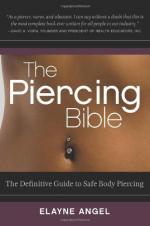|
This section contains 1,046 words (approx. 4 pages at 300 words per page) |

|
The piercing of body parts, also known as "body modification," has been practiced since ancient times, often to exhibit virility and courage, and frequently associated with royalty. For example, Egyptian pharaohs had their navels pierced as a rite of passage into manhood, and Roman soldiers pierced their nipples as a sign of masculinity and bravery. In Victorian times, members of royal families, both male and female, were known to have their genitals or nipples pierced. Current time-honored body piercing traditions include adorning the nose, lips, and navel, and some Native American tribes use body piercing in religious ceremonies. Not only limited to certain cultures, body piercing has become more common and widely accepted in the general population during the last part of the twentieth century. A piercing boutique in Los Angeles reported performing 18,000 piercings in 1993 alone.
In body piercing, the procedure is completed without anesthesia as...
|
This section contains 1,046 words (approx. 4 pages at 300 words per page) |

|


